| Article ID | Journal | Published Year | Pages | File Type |
|---|---|---|---|---|
| 4356506 | Hearing Research | 2006 | 16 Pages |
Abstract
Steady-state responses were evoked by noise stimuli that alternated between two levels of interaural correlation Ï at a frequency fm. With Ï alternating between +1 and 0, responses at fm dropped steeply above 4 Hz, but persisted up to 64 Hz. Two time constants of 47 and 4.4 ms with delays of 198 and 36 ms, respectively, were obtained by fitting responses to a transfer function based on symmetric exponential windows. The longer time constant, possibly reflecting cortical integration, is consistent with perceptual binaural “sluggishness”. The shorter time constant may reflect running cross-correlation in the high brainstem or primary auditory cortex. Responses at 2fm peaked with an amplitude of 848 ± 479 nV (fm = 4 Hz). Investigation of this robust response revealed that: (1) changes in Ï and lateralization evoked similar responses, suggesting a common neural origin, (2) response was most dependent on stimulus frequencies below 1000 Hz, but frequencies up to 4000 Hz also contributed, and (3) when Ï alternated between [0.2-1] and 0, response amplitude varied linearly with Ï, and the physiological response threshold was close to the average behavioral threshold (Ï = 0.31). This steady-state response may prove useful in the objective investigation of binaural hearing.
Keywords
2AFCdB SPLCSDFIRBOLDAVCNSNRMSOITDHSDdB HLCORRMSFFTBICBinaural masking level differenceBMLDAnalog-to-digitalMASTERElectroencephalogramstandard deviationMEGFast Fourier transformfunctional magnetic resonance imagingfMRIInteraural time differencehonestly significant differencetime constantsstandard error of the meanroot-mean-squaremedial superior oliveLATdecibel hearing levelSOCBinaural hearingsuperior olivary complexAuditory modelingSEMmagnetoencephalogramBinaural interaction componentdecibel sound pressure levelSignal-to-noise ratioEEGanteroventral cochlear nucleusCorrelationLateralizationFinite Impulse ResponseSteady-state responsesInferior colliculus
Related Topics
Life Sciences
Neuroscience
Sensory Systems
Authors
Hilmi R. Dajani, Terence W. Picton,
